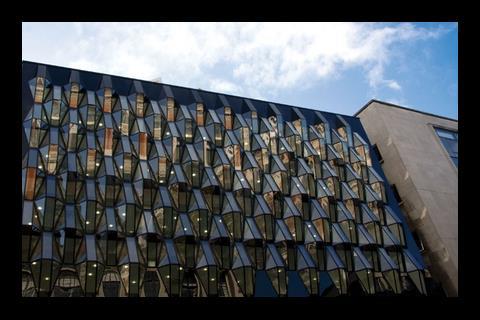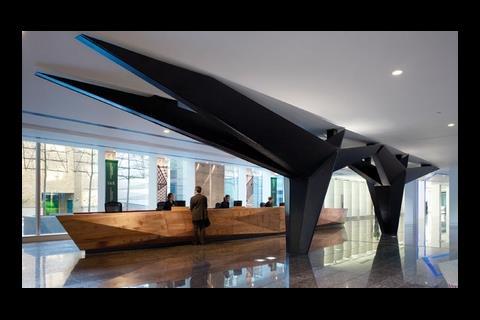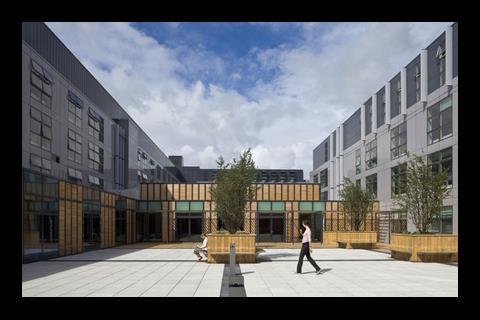As more owner-occupiers look for cheaper, more efficient and sustainable offices, refurbishment may provide the answer. Simon Rawlinson and Ian Harrison of Davis Langdon report
01 / Introduction
Despite the recent office boom, many organisations, particularly in the public sector, continue to occupy ageing and increasingly unsuitable stock, which can affect productivity, staff morale and an organisation’s brand.
Property has been identified in HM Treasury’s Operational Efficiency Review as an area for savings through increased efficiency and the disposal of excess space. Office refurbishment, driven by the three-way agenda of “spend to save”, organisational change and sustainable development will be an element of this strategy.
Many office buildings of the sixties and seventies are archetypal “rent-slabs”. Their often brutalist design has fallen out of favour, their internal planning is no longer fit for purpose and they are expensive and inefficient to run.
On the positive side, many sixties offices, particularly in the public sector, are located in town centres, so they contribute to the local economy and are well placed for public transport networks. Many also enjoy generous planning consents that permit a greater density of use than might be granted for a replacement, while some are beginning to enjoy “classic” status as tastes evolve. Owner-occupiers are also uniquely positioned to build an economic case based on whole-life costs and benefits related to lower tender prices and reduced energy consumption. Projects such as Hampshire council’s recently completed Elizabeth II Court exemplify a holistic approach that aims to improve the built environment, transform the organisation’s work and improve the environment for employees and clients (11 September, page 40).
Successful refurbishments depend on a flexible approach from the client and project team. An ability to compromise on requirements such as ceiling heights will save money and optimise the scope of work. For clients in the public sector who will have to balance choices related to affordability, sustainability and regeneration, the reuse of assets sends out a positive message to the workforce and stakeholders about the use of resources and long-term decision-making.
02 / Factors that determine suitability for refurbishment
An effective low-energy, sustainable refurbishment scheme relies on many aspects of the base building. Some, such as orientation, are fixed, and if not ideal will require design solutions. Others, such as an adequate slab-to-soffit height, are non-negotiable. Although a building has to have the right fundamentals to justify a major refurbishment, the project must work within its constraints to deliver the solution that the building “wants to be”.
- Orientation and massing. Careful orientation is the first principle of sustainable office design, but for refurbishment it will already be determined. East- and west-facing orientations, which expose occupants to glare and low sun will require more extensive solar shading or deep window reveals.
- Relationship to neighbours. The refurbishment may provide opportunities to improve the way the building relates to its surroundings, to provide a wider range of services and to provide an uplift to the location.
- Unrealised value. The base build may have features that have hidden “classic car” value.
- Location. Noisy roads will restrict the adoption of natural cross-ventilation strategies using opening windows, although other mixed mode options can be adopted.
- Floorplate width. This should lend itself to efficient open-plan space planning. The secondary criterion is cross-ventilation: window-to-window dimensions of 12-15m are ideal for this.
- Slab-to-soffit height. A distance of 2.6-2.7m is the minimum required to provide good quality accommodation, based on a single service void. In deeper plan or long, narrow accommodation, a higher soffit is desirable. Low ceilings require careful fenestration design and lighting to reduce their impact.
- Structural grids and floor loadings. Regular, well spaced grids facilitate efficient planning, but a high floor load capacity is not strictly necessary throughout, as owner-occupiers can adapt their operations to the constraints of the building.
- Soffit quality. Many design solutions seek to use the thermal mass of the soffit, but this is only possible if the build quality is good.
- Vertical circulation and services distribution. Circulation by stair and lift needs to be sufficient for the increased occupation density and to facilitate effective collaborative working. Lift location is also an issue, with “distributed” arrangements being less efficient than a single bank.
- The capacity and condition of drainage connections. Increasing the occupancy and intensity of the use of the building could exceed the capacity of the public health infrastructure, and the design should aim to deliver a low-water use scheme that does not increase waste outflows.
In summary, sixties and seventies office buildings have many attributes that make them suitable for comprehensive refurbishment. Owner-occupier clients who are able to adapt their operations to fit with the existing building are in a better position to secure these benefits than commercial developers, who need to be able to deliver a consistent product to the letting and investment market.
03 / Drivers for refurbishment
In the private rental sector, office refurbishment is often motivated by the need to reposition a building in its market – whether to extend its economic life through limited and targeted investment or to create an asset that can compete with top-quality new build space.
For owner-occupiers, there are often a wider set of objectives around organisational efficiency, management of resources and long-term flexibility, as well as the civic role of managing assets on behalf of stakeholders. The main drivers that are typically considered when determining the need for a refurbishment project include:
Organisational efficiency. The constraints of unmodernised space, such as cellular offices, include low occupational densities, low desk use, and most importantly, less than optimal team working.
Limited development options. In the current market, there is little interest in property disposals or development joint ventures, so owner-occupiers have few options but to redevelop their core assets.
Transformational change. Dramatic changes to ways of working aimed at changing organisational culture, such as the use of shared desk space, is easier to introduce as part of a bigger development programme, particularly if the scheme provides better quality workspace and facilities for employees.
Minimising running costs. Operating costs can be reduced by energy efficiency measures, but the greatest saving will be achieved by the improved use of space and desks, and the elimination of surplus space. Refurbishments not only need to enable greater intensity of occupation and low cost of churn, but also need to be adaptable enough to accommodate future changes in working.
Minimising environmental impacts. Many owner-occupiers recognise that construction projects present one-off opportunities to improve building performance. The reuse of assets and the minimisation of waste is a good start, and many buildings from the sixties and seventies are also well suited to low-energy operation – provided that the right envelope and services solutions are adopted.
Civic responsibility. Public sector clients have a responsibility to their staff, the wider community and the taxpayer that can encourage the client body to look at the wider impacts of development. Refurbishment strategies can send out strong messages about change in the organisation, commitment to the local economy and the responsible management of resources.
Regeneration. The development may provide opportunities to introduce new facilities and services into the locality.
04 / Accommodating new ways of working
Although flexible working, facilitated by seamless IT, has become almost ubiquitous among the users of modern office space, the occupants of many older buildings often find themselves working in an environment that constrains efficient space planning and working.
Refurbishment can lead to a wider change in organisational culture. It can enable the optimum use of the building, better cross-team working, the shared use of facilities and so on. The creation of this effective modern space requires a diverse range of work settings and equipment that can readily be incorporated into conventional office accommodation. When designing the refurbishment, some compromises may be required to make best use of the space:
- Space planning of meeting rooms and other cellular space. Multiple work settings have become a key principle of modern office design. In existing buildings, where there might be less flexibility for space planning, cellular space should be located where it will not disrupt other aspects of building operation such as natural ventilation. Spaces next to cores are often suitable for meeting rooms and printer centres.
- Acoustics of open-plan space. Where the environmental strategy makes use of exposed soffits, it is important to ensure that the resultant acoustic conditions are suitable for open-plan working.
- Effective IT infrastructure. A fully flexible IT set-up that supports shared desk occupancy and rapid churn is essential for modern working. If the IT cannot be accommodated in existing voids, risers and communication rooms, then alternative strategies such as Wi-Fi or thin-client systems (where most of the computing is done by a server rather than desktop PCs) may need to be considered.
- User-led environmental control. Providing limited control to occupants, such as opening windows is known to contribute to satisfaction and productivity. Other automated strategies, such as daylight control, work best if the changes in the office are perceived by users to be gradual.
- Using the character of the building. Features of the existing building such as the retained structure can be combined with other elements, such as external views, lighting, partitions, furniture and signage to produce distinctive and flexible space.
05 / Value and cost drivers
Office refurbishment will commit an owner-occupier to significant expenditure and will close off other options for the redevelopment of the building for many years. There are of course many options available to the client with regards to the extent of refurbishment, and the final solution should aim to give the best return with regard to the available budget, the expected life of the asset and the lifetime costs and benefits. In determining the optimum level of intervention and investment, the following factors should be considered:
- Building condition. This is, obviously, an important cost driver: structural constraints, the presence of asbestos and the need for concrete repairs are all significant cost risks.
- User expectations of internal conditions. A lower building performance specification will be acceptable to users if aspects of individual workspace control, the company’s dress code and so on are considered alongside it.
- External walls. Long and narrow sixties office buildings often have a relatively high wall-to-floor ratio, so replacement costs will also be relatively high. The contribution of the facade to environmental control should be maximised through mixed-mode operation such as opening lights and night-time cooling. Expectation management of external stakeholders during planning maybe a sensitive issue – particularly if the building is prominent and the original facade of poor quality.
- Remodelling. Depending on the location and sufficiency of openings in slabs and walls, the costs of structural remodelling may be extensive.
- Changing floor levels. The introduction of raised floors in office areas will mean that circulation spaces also have to be changed. This includes alterations to stair landings and lift lobbies.
- Mixed-mode building services solutions. Low energy and low running cost building services usually adopt a mixed-mode form, so that mechanical systems only operate when necessary. Investing in parallel systems, such as opening windows and back-up air-handling plant to deal with peak loads, together with the complex controls to run them will result in some premium costs.
- Plant space. Plant space and riser requirements are also likely to increase – if only in relation to dedicated systems for kitchens, cellular space and peak-lopping air-handling plant.
- New-build accommodation. Some aspects of the brief, such as entrance areas, may be better accommodated in new-build space that is free of the constraints of the existing structure. New build may also provide optimum solution to problems such as constrained circulation.
06 / Sustainable strategies
One of the principal advantages of going down the refurbishment route is the minimisation of waste and embodied energy associated with the demolition and construction of a substructure, frame and upper floors, which typically accounts for 50-60% of overall embodied energy. In addition, the following benefits can be secured – potentially reducing energy consumption by up to 70%, and also resulting in a substantial cut in water use.
- Building envelope performance. The building envelope contributes to the control of daylighting, glare control, air infiltration, thermal insulation, the provision of natural ventilation and, where appropriate, automated night-time purging. Robust, simple systems that do not create a major maintenance overhead are important for owner-occupiers.
- Thermal mass. Where suitable, the existing structure is a source of low-cost cooling if it has sufficient thermal mass and night-time purging is practised. Insitu concrete structures, ideally with ribbed or waffled floor slabs, are an important component of low energy refurbishment. They work best with clear air flows gained from generous floor-to-soffit heights.
- Natural ventilation and mixed-mode environmental control. Where location and the size and shape of floorplates permits, natural ventilation driven by cross-ventilation is the optimum low-energy solution – typically supplemented by night-time cooling. Natural ventilation can also be achieved using techniques such as the stack effect or negative air pressure – although this may require a good deal of modification to the building. Elizabeth II Court in Winchester, for example, was fitted with extract chimneys which exploit wind-driven negative pressure to draw air across office floors from opening lights.
- Reducing heat loads. The success of natural ventilation schemes also depends on reducing heat gain from lighting and office equipment such as PCs. Use of a server-based IT system with flat screens will reduce on-floor cooling loads, and printers can be located in hot spots with dedicated cooling. Some form of heat-lopping and supplementary ventilation is also provided as insurance for hot days.
- Lighting control. Lighting is a big source of heat load and energy consumption. One of the advantages of a typical narrow plan sixties office is that most of its accommodation will be located in perimeter zones with solar controlled dimming.
- Controls. Controls are a key element of sustainable building services installation and additional expenditure will be needed for occupancy sensors, window actuators and extensive metering to monitor the performance of the building and occupants.
Other issues such as water consumption, biodiversity and low impact travel should be considered as part of the briefing and design process.
07 / Buildability and risk management
Dealing with an existing building introduces many sources of uncertainty, and these can affect the scope of the work, the cost and the programme. The management of risks associated with the existing building is an important consideration in design and procurement.
Aspects of risk exposure include:
- The availability of information about the building’s original design and construction, including the existence of unrecorded alterations.
- The condition of the existing building, the quality of the original construction and the effects of settlement, wear and tear and so on.
- The effects of demolition, alteration and temporary works on the progress of the works and on the retained fabric.
For contractors, the ability to plan and sequence a construction programme that balances safety and stability with buildability and speedy construction is a critical skill – particularly as the chosen method may have to be adapted to suit site conditions. Other key planning and management issues include the scale of temporary works and protection required; the logistics of working within the existing structure and the varied workface conditions that need to be accounted for when preparing of method statements and short-term programmes.
One of the characteristics of refurbishment is that its attendant risks, such as structural weakness or the unexpected presence of asbestos, have to be dealt with if they occur. Risk avoidance is not usually an option. As many of these risks can emerge at an early stage in the project, it is crucial that they are resolved quickly so that the overall programme and budget are protected.
Realistic clients can make a huge contribution in driving a project forward, particularly if they recognise that it may not be possible to achieve normal levels of project certainty.
To minimise the impact of the unexpected, clients can help by appointing settled project teams that are capable of responding on their own initiative to change, and who can properly resource the job to deal with the unexpected. Effective teamwork and problem solving is an important aspect of risk management and mitigation on refurbishment projects.
08 / Cost model notes
This is based on the refurbishment of a 10,000m2, four-storey city-centre scheme, involving the stripping back of a sixties building to its original frame and floors.
The refurbishment includes structural alterations, new facades to create cross-ventilation and a complete reconstruction of fit-out and building services. Other aspects of the work include the construction of roof-level plant platforms and green roofs.
The rates in the breakdown are related to a competitively tendered lump sum contract with contractor’s design portions. Rates are current in third quarter 2009 based on a location in the South-east. Demolitions are included in the costs. External works, furniture and fittings, professional fees and VAT are excluded.
Acknowledgements
The authors would like to thank Peter Boote and Tom Brooker-Corcoran of Davis Langdon, Julian Lipscombe of Bennetts Associates and Steve Smith of DEGW for their assistance in the preparation of this article.
Downloads
7a / Extensive sustainable office refurbishment cost breakdown
Other, Size 0 kb


























No comments yet